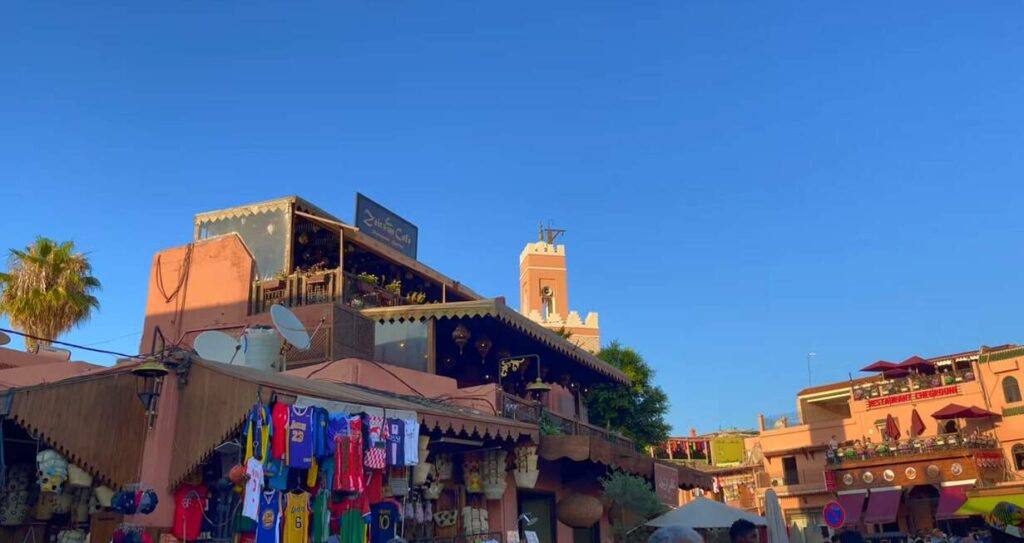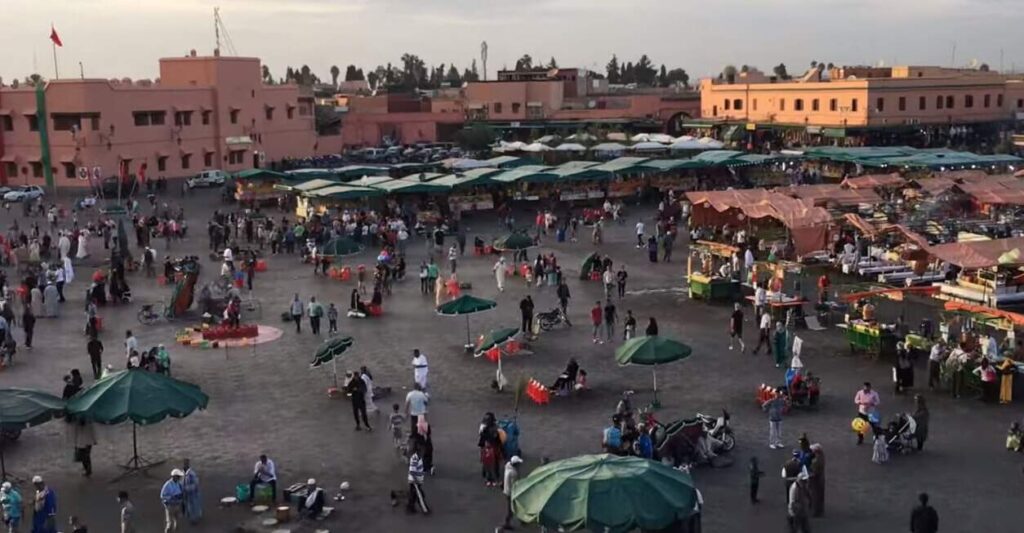Jemaa el-Fnaa, the beating heart of Marrakech, is a vibrant square that offers a sensory feast and a cultural immersion like no other.
Known for its dynamic atmosphere, this historic marketplace has been a hub of activity for centuries. By day, it’s filled with an array of vendors selling traditional crafts, aromatic spices, and tantalizing street food.
As night falls, the square transforms into a lively spectacle of entertainers; including musicians, dancers, and storytellers. Jemaa el-Fnaa is not just a market, it’s an experience that captures the essence of Moroccan culture and the spirit of Marrakech.
History of Jemaa El-Fnaa

Jemaa el-Fnaa square, the bustling heart of Marrakech, boasts a rich history that dates back to the 11th century.
Established during the Almoravid dynasty, the square quickly became a vital hub for trade and social interaction. Its strategic location near the Koutoubia Mosque ensured that it remained a central point for both locals and visitors.
In the early days, Jemaa el-Fnaa served as a marketplace where traders from across the region gathered to sell their goods. Over time, it evolved into a dynamic space for public gatherings, performances, and festivals.
The square’s name, which translates to “Assembly of the Dead” reflects its historical use as a site for public executions. Despite its grim moniker, Jemaa el-Fnaa gradually transformed into a vibrant cultural epicenter.
The Saadian dynasty, which reigned from the 16th to the 17th century, significantly influenced the square’s development.
During this period, Jemaa el-Fnaa flourished as a place of entertainment, with storytellers, musicians, and performers captivating audiences. The square’s eclectic atmosphere and cultural significance have only grown since then.
In the 20th century, the square, faced challenges as modernization threatened its traditional essence.
However, efforts to preserve its unique character culminated in Jemaa el-Fnaa being designated a UNESCO Masterpiece of the Oral and Intangible Heritage of Humanity in 2001.
Today, the square remains a lively, ever-changing mosaic of Moroccan life, blending history with contemporary vibrancy.
What is the Best Time to Visit Jemaa El-Fnaa?
The best time to visit Jemaa el-Fnaa, the vibrant heart of Marrakech, depends on what kind of experience you’re seeking. This bustling square offers different atmospheres throughout the day, each with its own unique charm.
In the early morning, Jemaa el-Fnaa is relatively quiet and serene. This is an ideal time for those who prefer a more tranquil experience.
You can explore the square and its surroundings, take in the architecture, and enjoy a peaceful breakfast at one of the nearby cafes. The morning light also makes for great photography opportunities without the distraction of large crowds.
As the day progresses, the square becomes busier. The late afternoon and early evening are when Jemaa el-Fnaa truly comes alive. This is the best time to experience the square’s dynamic energy, with its diverse array of street performers, musicians, snake charmers, and storytellers.
The air fills with the tantalizing aromas of food stalls, offering everything from freshly squeezed orange juice to traditional Moroccan dishes like tagine and couscous.
The night transforms Jemaa el-Fnaa into an even more magical place. The square is lit up by the glow of countless lamps and lanterns, creating a captivating atmosphere.
Nighttime is perfect for enjoying a leisurely dinner at one of the rooftop restaurants overlooking the square, providing a panoramic view of the lively scene below.
In short, the best time to visit Jemaa el-Fnaa depends on your preferences. For a quieter, more reflective experience, the morning is ideal. For those looking to immerse themselves in the vibrant culture and energy of Marrakech, the late afternoon to evening offers the most excitement.
Why is Jemaa El-Fnaa in Marrakech So Important?
Jemaa el-Fnaa is not just the central square of Marrakech; it is the pulsating heart of the city and a symbol of Moroccan culture. Its importance lies in its role as a living representation of the country’s rich history, traditions, and social life.
Established in the 11th century, Jemaa el-Fnaa has always been a place of gathering, trade, and entertainment.
One of the primary reasons Jemaa el-Fnaa is so significant is its function as a cultural hub. Every day, the square transforms into a bustling open-air theater, where traditional storytellers, musicians, dancers, and snake charmers captivate locals and tourists alike.
This preservation and presentation of Moroccan folklore and performing arts make Jemaa el-Fnaa a UNESCO Masterpiece of the Oral and Intangible Heritage of Humanity.
Moreover, Jemaa-el-Fnaa serves as a vital economic center. The square and its surrounding souks (markets) are filled with vendors selling everything from spices and textiles to handcrafted jewelry and traditional Moroccan lamps. This commerce supports countless local artisans and traders, contributing significantly to the local economy.
The square’s importance also extends to its role as a social meeting place. People from all walks of life converge here, making it a melting pot of cultures and a microcosm of Moroccan society.
Whether enjoying a cup of mint tea at a cafe, watching a street performance, or haggling over goods in the market, visitors and locals alike find common ground in this vibrant public space.
In essence, Jemaa el-Fnaa’s historical, cultural, and economic significance makes it an indispensable part of Marrakech and a must-visit for anyone wanting to experience the soul of Morocco.
What Do They Sell in Jemaa El-Fnaa?

Jemaa el-Fnaa, the bustling heart of Marrakech, is a shopper’s paradise offering a wide array of goods that reflect Morocco’s rich cultural heritage. The square and its surrounding souks (markets) are teeming with vendors selling an eclectic mix of items.
Spices are a major highlight, with vibrant displays of saffron, cumin, cinnamon, and other aromatic spices that perfume the air.
Handcrafted goods are also plentiful; intricate carpets, traditional Moroccan lamps, leather goods, and ceramics can be found in abundance. These items, often made by skilled artisans, offer a glimpse into the country’s craftsmanship traditions.
Textiles are another prominent feature, with stalls offering colorful scarves, embroidered kaftans, and woven blankets. Jewelry lovers will find a treasure trove of silver and Berber jewelry, featuring semi-precious stones and unique designs.
Food stalls area vital part of Jemaa el-Fnaa’s charm, selling everything from fresh-squeezed orange juice and traditional Moroccan sweets to more substantial fare like tagines and kebabs.
For those seeking beauty products, natural cosmetics such as argan oil and black soap are widely available. In addition, traditional medicinal herbs and remedies can be found, often promoted by local herbalists.
In essence, Jemaa el-Fnaa is a vibrant marketplace where the sensory overload of colors, sounds, and scents creates an unforgettable shopping experience.
Conclusion
Jemaa el-Fnaa is a must-visit destination that encapsulates the vibrant spirit and rich culture of Marrakech. Whether you’re exploring its bustling market by day or enjoying its lively entertainment at night, the square offers an unforgettable experience.
From tantalizing street food to captivating performances, Jemaa el-Fnaa provides a unique glimpse into Moroccan life, making it an essential stop on any journey through its enchanting city.
